Our Changing World for Thursday 9 August 2012
Restoring Maketu Spit
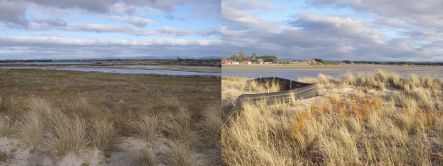
Looking from Maketu Spit towards lower Kaituna River and the Maketu-Ongatoro estuary (left), and one of the trapping fences crossing the spit, with golden pingao visible amongst the spinifex (images: A. Ballance)
Last week on Our Changing World we heard from Loder Cup winner Mark Dean and from Harley Spence about why sand dunes matter, and the work of the Dune Restoration Trust. This week we’re off to the Bay of Plenty, to see a project that won the Trust’s Best Coastal Dune Restoration Award in 2011.
The Maketu Ongatoro Wetland Society were also the Supreme Winner in the 2011 Western Bay of Plenty Community Awards for their work on Maketu Spit, just south-east of Te Puke.
On a fine winter day Alison Ballance joins local resident and Society member Julian Fitter for a walk along the 3.5. kilometre-long spit, which is an ecologically significant dune-wetland ecosystem. The Society has a 5-year biodiversity restoration plan, which involves trialling plantings of different species on the back dunes, removing weedy species such as pines, marram grass and tree lupins, and trapping introduced mammals such as hedgehogs and rats. An invertebrate survey found five undescribed species on the spit, and there are good numbers of skinks present. The end of the spit, nearest the village of Maketu, is an important breeding site for about 12 pairs of the endangered New Zealand dotterel.
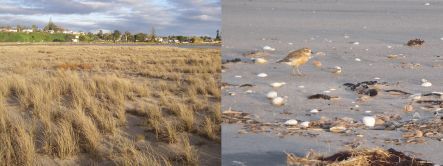
The New Zealand dotterel breeding area on the Maketu Spit, near the village of Maketu (left) and a New Zealand dotterel feeding on the beach (images: A. Ballance)
Cochlear Microphonic
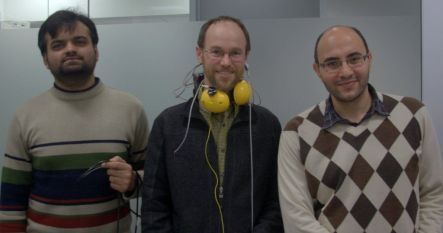
From left to right: Asim Masood, Paul Teal and Mohammad Ayat doing an experiment to see if they can detect spontaneous cochlear microphonic in Paul's left ear
Paul Teal and Asim Masood are developing a new non-invasive technique for measuring the cochlear microphonic signal. The cochlea is a spiraling, snail like chamber that takes sound and turns it into electrical signals. The electrical signal is primarily produced by the outer hair cells along the length of the cochlear, with their primary function being to amplify the acoustic wave along the cochlear.
Using gold-plated foam ear plugs with electrodes clipped on to them, the team (which includes Mohammad Ayat who is working on modelling) hope to harness these electrical signals from deep inside the ear. Measuring how strong the cochlear microphonic signal is, will provide a way of indicating how healthy their outer hair cells are.
A healthy cochlea also amplifies quiet sounds more than loud sounds, and current tests for hearing loss measures the softest sounds but is less reliable at measuring how well the louder sounds are heard. Ultimately, Paul Teal hopes to create a device for testing hearing which could give an automatic read-out on the make-up of the hearing aid that is needed.
Seafood Safety
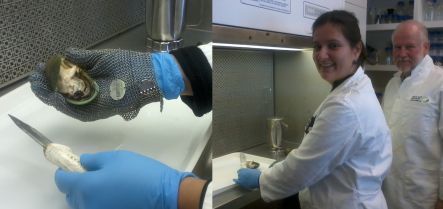
Shucking a greenshell mussel, and Cristina Cruz and Graham Fletcher in the Food Pathogen Lab (images: A. Ballance)
The New Zealand greenshell mussel industry is worth over $200-million a year, while our oyster industry has, until recent problems with the herpes virus, been making tens of millions of dollars a year. Plant and Food Research is working with industry to ensure that shellfish arrive on consumers’ plates free of any bacteria or other pathogens that might cause diseases such as listeriosis.
To find out about the seafood safety programme Alison Ballance heads to the Food Pathogen Lab at the Mount Albert Research Centre to meet Cristina Cruz and Graham Fletcher. She discovers that as well as regular monitoring of samples looking for the presence of Listeria monocytogenes and Vibrio parahaemolyticus bacteria, both of which cause gastroenteritis and can be fatal, the Lab is also involved in work such as identifying the most effective sanitiser to use in seafood procesing facilities, and developing smart food packaging.
Wetapunga Breeding Programme
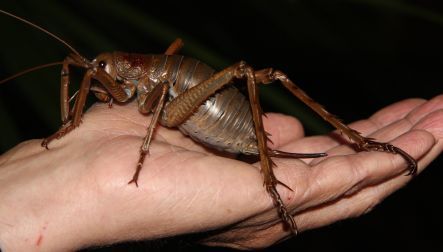
A fully-grown female wetapunga, ready for transfer to Auckland Zoo (image: Auckland Zoo)
Wetapunga are the largest insect in New Zealand, and with females weighing in at 35 grams or more they are one of the heaviest insects in the world. These spectacular giant weta are a threatened species, and their presence in the wild is restricted to just one natural population on Hauturu-0-Toi/Little Barrier Island, and two recently introduced populations on Tiritiri Matangi and Motuora islands in the Hauraki Gulf.
The Department of Conservation’s Threatened Weta Recovery Plan calls for captive breeding populations to be established to try to boost their numbers and to eventually return them to the mainland. Paul Barrett at Butterfly Creek in South Auckland has been 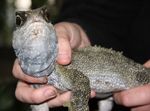 successfully breeding wetapunga for some time, and now Auckland Zoo has joined him. The intention is to not just breed for release but also to enhance advocacy for the insects by having them on display to the public.
successfully breeding wetapunga for some time, and now Auckland Zoo has joined him. The intention is to not just breed for release but also to enhance advocacy for the insects by having them on display to the public.
Auckland Zoo translocated their insects from Little Barrier Island and Justin Gregory went on a recent collecting trip, along with the Department of Conservation’s Chris Green, and Richard Gibson and Ian Frazer from Auckland Zoo. Justin also briefly got to meet the tuatara Rudolf (above left, image by Auckland Zoo), being returned to the breeding enclosure on the island after treatment at the zoo for a broken and then infected jaw.
An adult weta feeding at night (footage: Auckland Zoo)
Mystery Sound
Our fourth mystery sound from the opening theme is a Henry self-setting possum trap going off. You can find a podcast about that trap here. You can also listen to Kim Hill talking to Goodnature’s Stu Barr about their range of self-setting traps here.